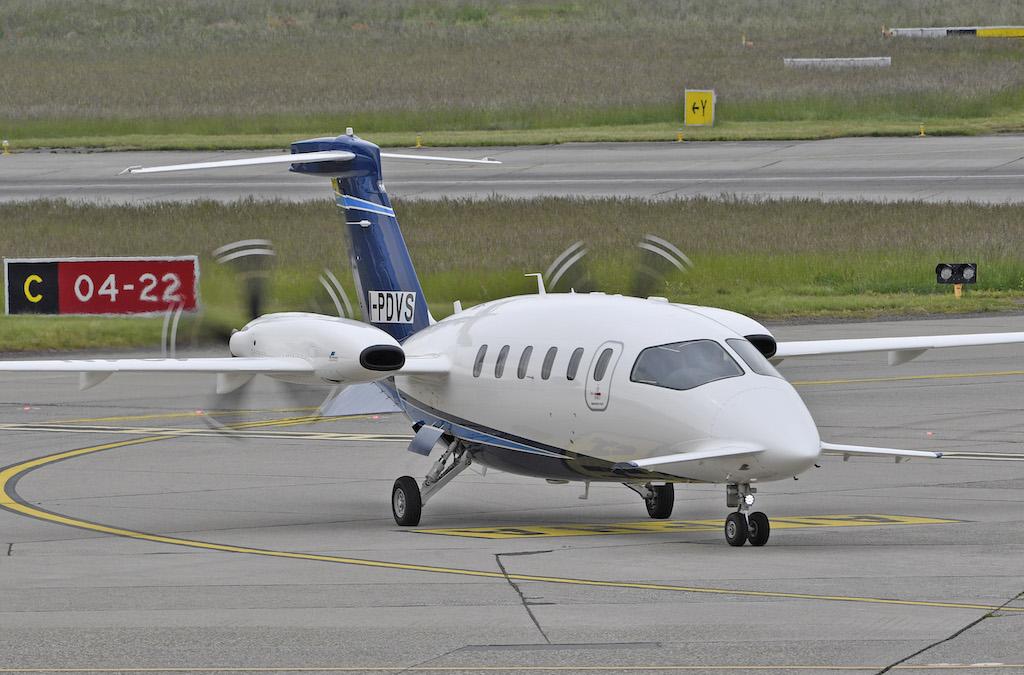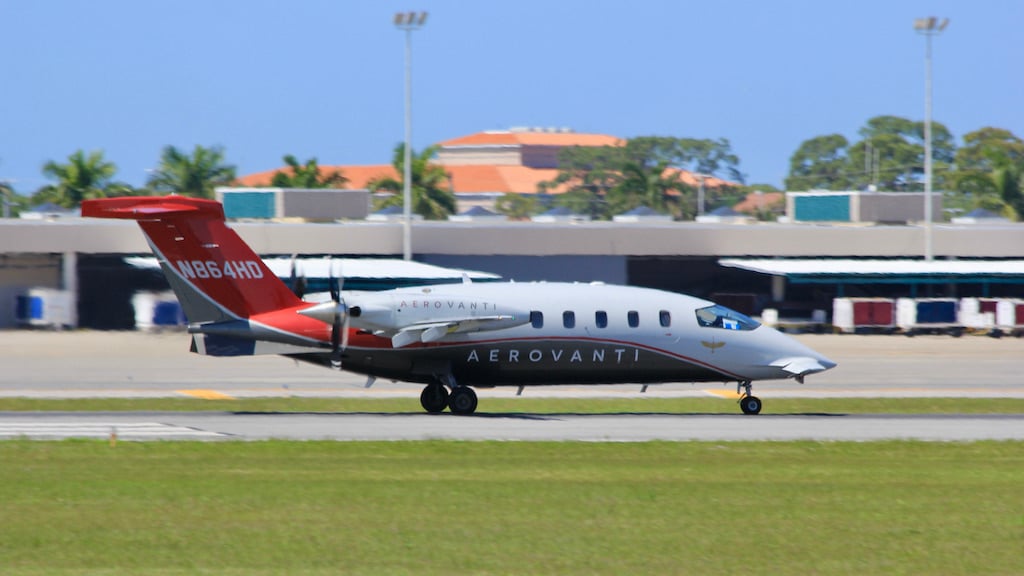
A Piaggio Avanti II arrived in Geneva for the EBACE conference in May.
Italian government-appointed commissioners received 18 expressions of interest in acquiring Piaggio Aerospace as of a June 19 deadline, suggesting that the manufacturer of the iconic P.180 twin turboprop will remain a viable concern.
Piaggio Aerospace, consisting of subsidiaries Piaggio Aero Industries and Piaggio Aviation, has been in extraordinary receivership since December 2018, when Abu Dhabi-owned Mubadala Development Co. withdrew its 100% share in the company. The 18 expressions of interest (EOI), including half from businesses with headquarters in Italy, came during a fourth attempt to sell Piaggio.
“The market is sending us encouraging signals,” the commissioners stated. "Most of the EOIs were submitted by prominent business parties. “This acknowledges once again the attention for a national strategic company with a significant potential, especially considering the latest developments on sustainable mobility.”
Based in Villanova D’Albenga, near Genoa, Piaggio didn’t skip a beat after Mubadala withdrew its investment. “The company has been operating continuously, without a break, despite the [Covid 19] pandemic,” Davide Rossetti, one of the three commissioners, told BCA’s Angus Batey during the EBACE conference in May. “The order portfolio has increased during this time, and there’s been no negative impact on jobs—no temporary layoffs.”
At the time, the manufacturer had an order backlog of 17 P.180 Avanti EVOs, from both Italian government institutions and private customers. Its order book was valued at €550 million ($593 million).
A Unique Design

With its fixed forward wing, curving low-drag fuselage and twin pusher engines, the P.180 Avanti has been likened in appearance to a catfish or a hammerhead shark—the latter being inspiration for the uncrewed P.1HH HammerHead military reconnaissance derivative of the P.180. The type’s three lifting surfaces of the forward wing, main wing and horizontal stabilizer work together for aerodynamic efficiency.
Designed by a team of engineers headed by Alessandro Mazzoni to match the speed of a jet with the fuel efficiency of a turboprop, the P.180 first flew in 1986 and was certified in 1990. Powered by 850-shp Pratt & Whitney PT6A-66 turboprop engines, the Avanti seated up to nine occupants and came with a sticker price of $4.1 million.
Piaggio certified the Avanti II in 2006; it featured a new Collins Pro Line 21 avionics suite, upgraded PT6-66B engines and increased maximum takeoff weight to 12,050 lb. In December 2014, the manufacturer announced European Union Aviation Safety Agency certification of the third-generation Avanti EVO.
The EVO improved the aircraft’s noise signature by fitting the PT6s with patented exhaust stacks and Hartzell low rpm, counter-rotating 5-blade scimitar propellers. Winglets on the main wing and new front-wing wingtips improved max cruise range to 1,770 nm and climb speed to 35,000 ft. by 10%. Max speed of the EVO is 402 KTAS. The more efficient wing combination increased its service ceiling to 41,000 ft.
Aviation Week’s Fleet Discovery Database counted a world in-service fleet of 205 P.180 Avantis in June, consisting of 117 Avanti IIs, 57 original P.180s, 17 military P.180AMs and 14 EVOs. There were five aircraft in the possession of a third party.
The 2022 factory-new list price of a P.180 Avanti EVO was $7.7 million; the average retail price was $7.2 million, according to the Aircraft Bluebook.
There were 17 P.180s listed for sale in June, including Avanti IIs and Avanti EVOs, said Bryon Mobley, president and managing partner of Wetzel Aviation, of Englewood, Colorado. Of these, about half had been advertised for a year or longer, he said. “This isn’t an indication of a slow market, rather you are seeing the same high-time, ‘maintenance challenged’ and relatively inaccessible aircraft that just don’t move,” Mobley explained.
Earlier P.180s sell in the ballpark of $1.5 million to $2 million; Avanti IIs for $2 million-$3.5 million; and EVOs for $5 million-$8 million, depending on how new they are, Mobley said. There are a lot of variables in pricing, he added, such as for engine time remaining, landing gear overhaul status or airframes that have had Garmin’s GTN 750 avionics interface installed.
Which other types compete for sales with the P.180 Avanti? “This is interesting, because I think most [prospective buyers] that approach us for pre-owned or new aircraft aren’t really considering anything else,” Mobley said. “They just want a Piaggio.
“If I had to suggest general competition for the aircraft, I’d say probably the Cessna CJ2/3/4 series rather than any other turboprop,” he said. “Simply because the P.180 can provide a much nicer cabin experience for less fuel. There is a speed difference for sure, but depending on the trip, it may not be massively significant.”
Reconfigurable Cabin

The Avanti EVO cabin is pressurized and measures 5.74 ft. high, 6.07 ft. wide and 14.92 ft. long. Its external baggage compartment holds up to 350 lb. There are several different cabin configurations available—the typical executive layout is for six passengers and one pilot—and include galley space and an enclosed lavatory with a belted seat aft. At the European Business Aviation Conference & Exhibition in May in Geneva, Piaggio introduced a quick-change shuttle configuration with high density seating for seven passengers that can be reconfigured for cargo or medevac operations.
Basic hourly maintenance intervals for the Avanti start at 200 hr., followed by a B check at 600 hr., C check at 1,800 hr. and D check at 3,600 hr. “The landing gear overhaul is very expensive and a heavily discussed item but is only due at either 12-year intervals or 6,000 landings, whichever occurs first,” Mobley said. Engine intervals are the same as other similar PT6s, with hot section inspection at 1,800 hr. and overhaul at 3,600 hr.
“Factory support is always discussed with potential buyers,” Mobley said. “Sometimes it can be problematic, and sometimes operators must rely on used or ‘as removed’ parts, but Piaggio does work actively to support the aircraft.
“But they aren’t a massive corporation with thousands of aircraft in operation, so they don’t have the economies of scale that Textron might, so parts can be expensive, and things don’t always move quickly,” he added. “It is probably also worth noting that from what we’ve heard in other markets, there are still a lot of supply chain issues right now industrywide.”
BCA welcomes comment and insight from aircraft dealers and brokers for its monthly 20/Twenty pre-owned aircraft market feature. The focus aircraft for July 2023 is the Piper M600 and for August 2023 the Pilatus PC-12. To participate, contact [email protected].





